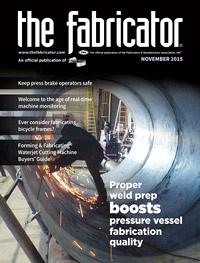Senior Editor
- FMA
- The Fabricator
- FABTECH
- Canadian Metalworking
Categories
- Additive Manufacturing
- Aluminum Welding
- Arc Welding
- Assembly and Joining
- Automation and Robotics
- Bending and Forming
- Consumables
- Cutting and Weld Prep
- Electric Vehicles
- En Español
- Finishing
- Hydroforming
- Laser Cutting
- Laser Welding
- Machining
- Manufacturing Software
- Materials Handling
- Metals/Materials
- Oxyfuel Cutting
- Plasma Cutting
- Power Tools
- Punching and Other Holemaking
- Roll Forming
- Safety
- Sawing
- Shearing
- Shop Management
- Testing and Measuring
- Tube and Pipe Fabrication
- Tube and Pipe Production
- Waterjet Cutting
Industry Directory
Webcasts
Podcasts
FAB 40
Advertise
Subscribe
Account Login
Search
Celebrating the people in manufacturing
Manufacturing Day honors the act of finding a better way
- By Tim Heston
- November 4, 2015
- Article
- Shop Management

Here’s to another successful Manufacturing Day, celebrating people working together, sharing ideas, and making lives easier.
When Manufacturing Day comes along again, I will from this point onward think of poultry.
On Oct. 2, this year’s Manufacturing Day, more than 2,000 events were held at companies, schools, and other venues across the country. I attended one hosted by Metcam, a precision metal fabricator north of Atlanta.
The shop looks little like it did just two years ago. The company had arranged its assembly area into color-coded cells. By “the company” I don’t mean leaders who pushed changes down; I mean assembly folks who met over several kaizens to make their jobs, along with the entire organization, more efficient.
The company, primarily a contract fabricator, is also collaborating with more entrepreneurs to launch products—and this is where chickens enter the story. For years the poultry industry has transported chickens in steel cages. Steel weighs a lot, so much that it limits the number of chickens that can fit in a trailer. Metcam has helped an entrepreneur design an aluminum product that not only gives chickens more room, but saves a lot of weight, meaning trucks can transport more chickens at one time.
The challenge has been designing such a cage system that’s cost-competitive, considering the high price of aluminum versus steel. The people at Metcam overcame this by designing the cages to be modular. They require absolutely no welding and can be bolted together in different configurations. So while the raw material may cost more, the manufacturing process costs less.
For me, these two stories really illustrate what modern manufacturing is all about: helping an entrepreneur perfect an idea, and people coming together (in this case, in Metcam’s assembly department) to uncover a better way to get the job done.
Manufacturing Day is helping to spread the word and combat the industry’s image problem that just won’t go away, although it’s understandable why the image persists, considering how layoffs and shuttered plants affected so many communities over the years.
The image is changing, though. When companies like Deere or Caterpillar struggle, many attribute those struggles to market conditions—food prices, mining sector, commodity markets—not to any failing of manufacturing.
Yet the hunt for skilled people continues unabated. Why don’t more people consider manufacturing as a career? I don’t think the reason is entirely an image problem. Instead, I think it’s a communication problem. When people visit a plant, they see the machines, they see the parts and assemblies, but there’s so much more going on, and a lot of it is much more interesting (and for many more fulfilling) than many office jobs.
I occasionally get calls from people who are pitching ideas for TV shows. They tell me they’re looking for people with charisma, with presence, perhaps that independent spirit. Of course, they’re looking for fodder that will make good television, and good television usually doesn’t reflect reality.
Reality TV that shows metal fabrication tools in action (particularly welding) tends to focus on the craft, like a hot rod or art project, and that’s great. But they also show the drama. Seeing people scurrying around to overcome insurmountable odds may make good television, but it doesn’t make a successful business.
When visitors toured Metcam they didn’t see much drama. Nor did they see a monotonous assembly line with workers doing the same thing hour after hour, day after day. Instead, tour guides described how people focus on the process—on tool organization, labeling, and product flow.
When you have just a sentence or two to describe continuous improvement, it sounds really dull, and it’s tough for some outside the business to grasp. But behind all the minutiae of takt time and kanban technicalities, process improvement is at its heart a very human activity. It makes manufacturing social. People aren’t confined to their work area or their place on the assembly line. They instead get a lot of satisfaction working together as a team to improve a process and make life easier, both for people inside the company and for the customer.
For many the product they’re making is interesting; the machines they’re working on are fascinating; but the teamwork, the interaction with others—be it for a new product or process—is the reason they come to work in the morning.
Today you may be more likely to get this kind of interaction on the shop floor than in a cube farm on the umpteenth floor of some corporate high-rise. Consider Jim Mauro. He got his start with a custom fabricator decades ago, then landed jobs at well-known firms in the corporate world. He also spent time in mergers and acquisitions as a broker.
He said that in much of the corporate world, money is all that matters. And when money is all that matters, the worst of human nature comes to the fore. Money matters in metal fabrication and in manufacturing overall, of course, but if money is the only thing driving someone, that person probably won’t choose manufacturing. There are easier ways to make a buck.
After all that time in the corporate world, Mauro recently decided to get back into custom fabrication and launched MicroFab LLC, based in Spring Hill, Fla. Why, exactly? “I had a burning desire to do it,” he said. “I get tremendous satisfaction out of making something. And I missed the people.”
That pretty much sums it all up. Here’s to another successful Manufacturing Day, celebrating people working together, sharing ideas, and making lives easier.
For more information on Manufacturing Day, visit www.mfgday.com.
About the Author

Tim Heston
2135 Point Blvd
Elgin, IL 60123
815-381-1314
Tim Heston, The Fabricator's senior editor, has covered the metal fabrication industry since 1998, starting his career at the American Welding Society's Welding Journal. Since then he has covered the full range of metal fabrication processes, from stamping, bending, and cutting to grinding and polishing. He joined The Fabricator's staff in October 2007.
Related Companies
subscribe now

The Fabricator is North America's leading magazine for the metal forming and fabricating industry. The magazine delivers the news, technical articles, and case histories that enable fabricators to do their jobs more efficiently. The Fabricator has served the industry since 1970.
start your free subscription- Stay connected from anywhere

Easily access valuable industry resources now with full access to the digital edition of The Fabricator.

Easily access valuable industry resources now with full access to the digital edition of The Welder.

Easily access valuable industry resources now with full access to the digital edition of The Tube and Pipe Journal.
- Podcasting
- Podcast:
- The Fabricator Podcast
- Published:
- 04/16/2024
- Running Time:
- 63:29
In this episode of The Fabricator Podcast, Caleb Chamberlain, co-founder and CEO of OSH Cut, discusses his company’s...
- Trending Articles
How to set a press brake backgauge manually

Capturing, recording equipment inspection data for FMEA

Tips for creating sheet metal tubes with perforations

Are two heads better than one in fiber laser cutting?

Hypertherm Associates implements Rapyuta Robotics AMRs in warehouse

- Industry Events
16th Annual Safety Conference
- April 30 - May 1, 2024
- Elgin,
Pipe and Tube Conference
- May 21 - 22, 2024
- Omaha, NE
World-Class Roll Forming Workshop
- June 5 - 6, 2024
- Louisville, KY
Advanced Laser Application Workshop
- June 25 - 27, 2024
- Novi, MI


























